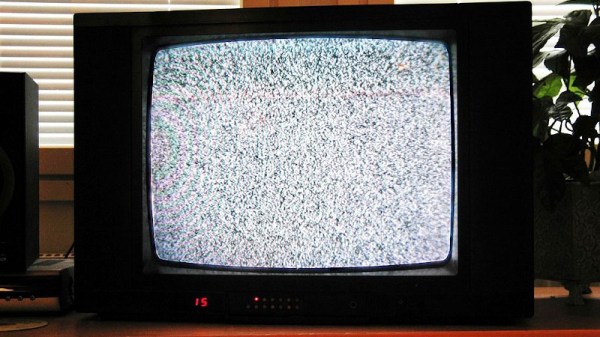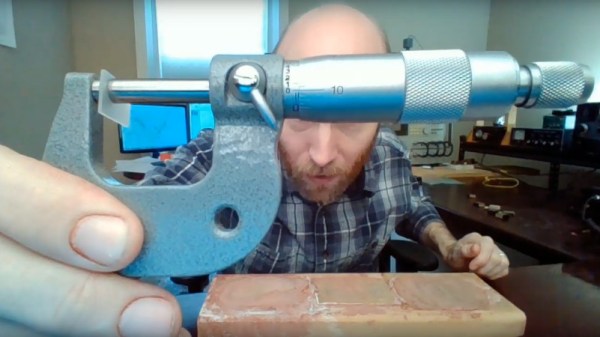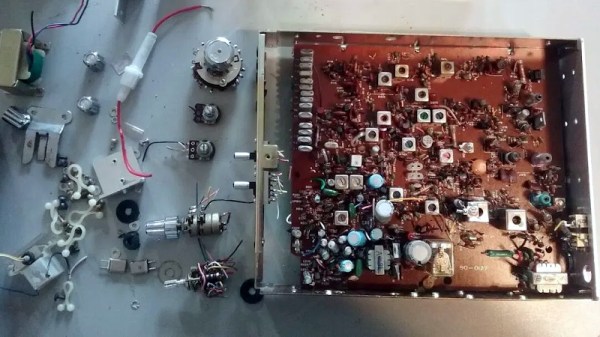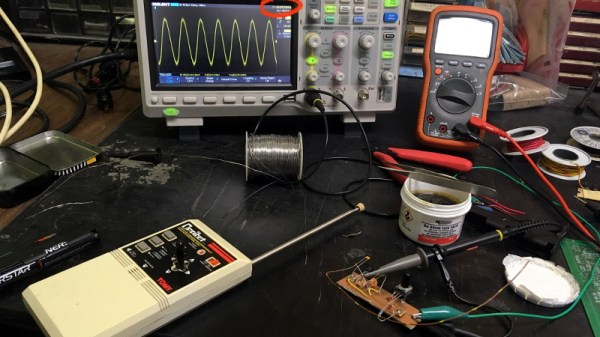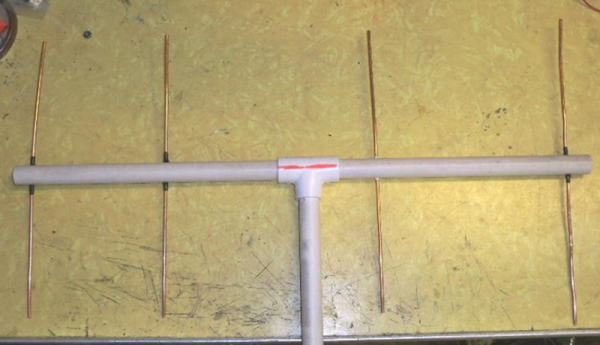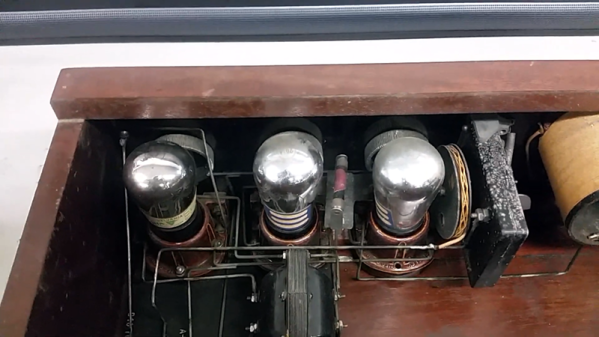There are many ways in which one’s youth can be misspent, most of which people wish they’d done when they get older and look back on their own relatively boring formative years. I misspent my youth pulling TV sets out of dumpsters and fixing them or using their parts in my projects. I recognise with hindsight that there might have been a few things I could have done with more street cred, but for me, it was broken TVs. Continue reading “Understanding A Bit About Noise Can Help You Go A Long Way”
Radio Hacks1445 Articles
Pulling A Crystal By Grinding It
If you own a radio transmitter, from a $10 Baofeng handheld to a $1000 fancy all-band transceiver, setting the frequency is simply a case of dialing in where you want to go. A phase-locked-loop frequency synthesizer or a software-defined radio will generate your frequency, and away you go. There was a time though when synthesizers were impossibly complex and radio amateurs were faced with a simple choice. Use an LC oscillator and put up with drifting in frequency, or use a crystal oscillator, and be restricted to only the frequencies of the crystals you had. [Mark Erdle, AE2EA] modified a 1950s broadcast AM broadcast transmitter for the 1.8MHz amateur band, and his friend [Andy Flowers, K0SM] thought it needed its crystal back for originality rather than the external frequency source [Mark] had provided. He documents the process of modifying a crystal oven and moving a crystal frequency in the video below the break.
A crystal oven is a unit containing the crystal itself alongside a thermostatic heater, and in this one, the crystal was a 1970s-vintage hermetically sealed HC6 device. He modified the oven to take a socket for older FT243 crystals because the quartz element can easily be accessed. [Andy] picked a crystal as close as he could find below the required frequency. He then ground it down with very fine grit on a glass plate, reducing its mass and thus its resonant frequency. We’re taken through the process of getting it close to frequency, but sadly don’t see the etching that he uses for the very last stage. At the end of the video, we see a QSO on the transmitter itself, which is something of an oddity in an age when AM on amateur bands has been supplanted by other modes for decades.
If you’re curious about the transmitter there’s a video thread following its restoration, and if the guts of older radio gear interests you then take a look at this aircraft receiver lovingly brought back to life.
What Will You Do With An Extra 1.2 Gigahertz?
While our collective minds have been turned towards the global pandemic it’s refreshing to hear that in some quarters life has continued, and events that would have made the news in more normal times have continued to take place while they have been replaced in coverage by more urgent considerations.
In the last few weeks there has been a piece of routine American bureaucracy that flew under the radar but which will have a significant effect on global technology; the United States’ Federal Communication Commission first proposed, then ratified, the allocation of an extra 1200 MHz of spectrum in the 6 GHz band to ISM usage. This allocation process is likely to be repeated by other regions worldwide, freeing up another significant piece of spectrum for unlicensed usage.
In practice this means that there will be a whole new set of WiFi channels created, and we’ll all have a little more spectrum to play around with, so it’s worth examining in a little more detail. Continue reading “What Will You Do With An Extra 1.2 Gigahertz?”
The Lost Art Of Component Scavenging
With the easy and cheap availability of parts by Internet mail order, it’s easy to forget that acquiring electronic components was once a more tedious process, and it was common to use salvaged parts because they were what you had. Scouring a panel from a dumpster-find TV for the right resistor may now be a thing of the past, but it’s not entirely dead. [Ryan Flowers] was lucky enough to score a box of old CB radios at a garage sale, and takes us through a teardown in search of parts he can use to make a QRP amateur radio rig. Delving into aged electronics is right up our street!

A possibility for a 27 MHz CB rig is to convert it to the neighbouring 10 m amateur band, but since these were all AM rigs, a mode that sees very little amateur use, it was better to part them out. It’s an interesting study in the evolution of radio design, as an entirely analogue design of mostly discrete components is revealed.
Careful inspection of the photographs reveals a Fairchild uA703 5-transistor IF amplifier chip in a metal can, but that’s about as high-tech as it gets. Unexpectedly there is a huge bank of crystals rather than the frequency synthesiser that would have been standard only a few years later.
He comes away with the chassis, switches and pots, and the RF inductors and crystals from the PCB. Those miniature Toko inductors used to be a common sight, but are now something of a rarity. If you fancy a wallow in semiconductors from this era we’ve previously taken a look at the vintage Fairchild catalogue, in which the uA703 is on page 398.
Building A New RF Remote From Scratch
We’ve seen no shortage of projects that use the ESP8266 or ESP32 to add “smart” features to existing home appliances, often by pairing the microcontroller with a radio or IR transmitter. If your device has an existing remote, integrating it into a custom home automation system is often just a matter of getting a few cheap modular components and writing some simple code to glue it all together.
But what if the appliance you want to control doesn’t use a common frequency? That’s a question that [eigma] recently had to answer after finding the remote control for the bedroom ceiling fan was operating at a somewhat unusual 304 MHz. Something like the MAX1472 could probably have been tuned to this frequency, but the chip doesn’t seem to be available in a turn-key module as the popular 315 MHz transmitters are.
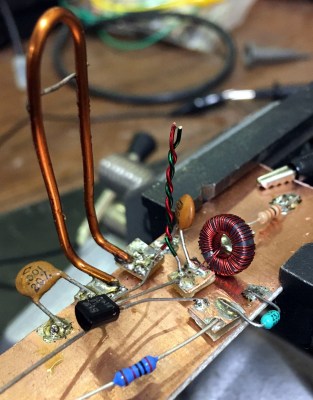 There were a few possible options, including using a software defined radio (SDR), but [eigma] didn’t want to spend a fortune on this project or wait months for parts to get shipped from overseas. The most straightforward solution was to design a custom transmitter tuned to the proper frequency using discrete components; something of a dark art to those of us who’ve been spoiled by the high availability of modular components.
There were a few possible options, including using a software defined radio (SDR), but [eigma] didn’t want to spend a fortune on this project or wait months for parts to get shipped from overseas. The most straightforward solution was to design a custom transmitter tuned to the proper frequency using discrete components; something of a dark art to those of us who’ve been spoiled by the high availability of modular components.
What follows is an fascinating look at the design, testing, and troubleshooting of a truly scratch-built transmitter. You won’t find any ICs here, the carrier signal is generated with just a transistor, some carefully measured pieces of wire, and a handful of passive components. By modulating the signal with an ESP32, [eigma] successfully makes the oddball ceiling fan an honorary member of the Internet of Things.
The write-up that [eigma] has done is an absolutely invaluable resource if you ever find yourself in need of rolling a bespoke transmitter. It easily ranks among some of the most informative radio reverse engineering work we’ve covered, and you’d be wise to file this one away for future reference. That said, most of the newer hardware you’re going to run into will probably be utilizing a widely-supported frequency like 433 MHz.
Beat Your Coat Hangers Into Antennas, Not Plowshares
If you are looking for a fun project while you are cooped up and you have some spare coathangers, why not try this 4-element Yagi antenna (PDF)? [Pete N8PR] showed it off at his local ham radio club and it looked like something good for a lazy afternoon. If you aren’t a ham, you could adjust it all for a different VHF or UHF frequency.
For the boom, [Pete] mentions you can use wood, but it isn’t weather resistant. He chose half-inch PVC pipe. He also offers you a choice of material for the elements: #8 wire, welding rod, or — our favorite — coat hangers.
This is a big upgrade from a simple dipole or a vertical made from coax. The yagi should have about 8 dBi gain in the direction it is pointing. The center of the boom doesn’t have any elements, so that simplifies mounting. The insulating boom also makes mounting the driven element a breeze.
If you use the coat hangers, we’ve heard an easy way to get them very straight is to put one end on a vise and the other end in a drill chuck (see the video below). The method will weaken the wire, but the elements won’t have much stress. If it worries you, just go slow on the drill and you might consider annealing the wire with a torch afterward.
It would be easy to make this portable like some other designs we’ve seen. If you want the history and theory behind the venerable yagi antenna, you’ll want to revisit this post.
Continue reading “Beat Your Coat Hangers Into Antennas, Not Plowshares”
Odd Crosley Radios From The 1920s
You may sometimes see the Crosley name today on cheap record players, but from what we can tell that company isn’t connected with the Crosley Radio company that was a powerhouse in the field from 1921 to 1956. [Uniservo] looks at two of the very early entries from Crosley: the model VIII and the XJ. You can see the video of both radios, below.
The company started by making car parts but grew rapidly and entered the radio business very successfully in 1921. We can only imagine what a non-technical person thought of these radios with all the knobs and switches, for some it must have been very intimidating.

